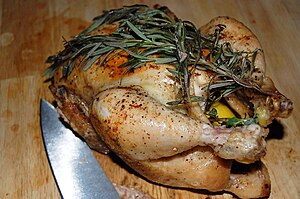Tebasaki

Oven-roasted rosemary and lemon chicken
|
|
| Course | Starter, main meal, side dish |
|---|---|
| Serving temperature | Hot and cold |
| About 120 calories kcal | |
| |
|
| Nutritional value per 100 g (3.5 oz) | |
|---|---|
| Energy | 916 kJ (219 kcal) |
|
0.00 g
|
|
|
12.56 g
|
|
| Saturated | 3.500 g |
| Monounsaturated | 4.930 g |
| Polyunsaturated | 2.740 g |
|
24.68 g
|
|
| Tryptophan | 0.276 g |
| Threonine | 1.020 g |
| Isoleucine | 1.233 g |
| Leucine | 1.797 g |
| Lysine | 2.011 g |
| Methionine | 0.657 g |
| Cystine | 0.329 g |
| Phenylalanine | 0.959 g |
| Tyrosine | 0.796 g |
| Valine | 1.199 g |
| Arginine | 1.545 g |
| Histidine | 0.726 g |
| Alanine | 1.436 g |
| Aspartic acid | 2.200 g |
| Glutamic acid | 3.610 g |
| Glycine | 1.583 g |
| Proline | 1.190 g |
| Serine | 0.870 g |
| Vitamins | |
| Vitamin A equiv. |
(6%)
44 μg |
| Pantothenic acid (B5) |
(13%)
0.667 mg |
| Minerals | |
| Iron |
(9%)
1.16 mg |
| Sodium |
(4%)
67 mg |
| Other constituents | |
| Water | 63.93 g |
|
Not including 35% bones.
|
|
|
|
| Percentages are roughly approximated using US recommendations for adults. Source: USDA Nutrient Database |
|
Chicken is the most common type of poultry in the world.
In developed countries, chickens are usually subject to intensive farming methods.
The modern chicken is a descendant of red junglefowl hybrids along with the grey junglefowl first raised thousands of years ago in the northern parts of the Indian subcontinent.
Chicken as a meat has been depicted in Babylonian carvings from around 600 BC. Chicken was one of the most common meats available in the Middle Ages. It was eaten over most of the Eastern hemisphere and a number of different kinds of chicken such as capons, pullets and hens were eaten. It was one of the basic ingredients in the so-called white dish, a stew usually consisting of chicken and fried onions cooked in milk and seasoned with spices and sugar.
In the United States in the 1800s, chicken was more expensive than other meats and it was "sought by the rich because [it is] so costly as to be an uncommon dish." Chicken consumption in the United States increased during World War II due to a shortage of beef and pork. In Europe, consumption of chicken overtook that of beef and veal in 1996, linked to consumer awareness of Bovine spongiform encephalopathy (mad cow disease).
Modern varieties of chicken such as the Cornish Cross, are bred specifically for meat production, with an emphasis placed on the ratio of feed to meat produced by the animal. The most common breeds of chicken consumed in the US are Cornish and White Rock.
...
Wikipedia
